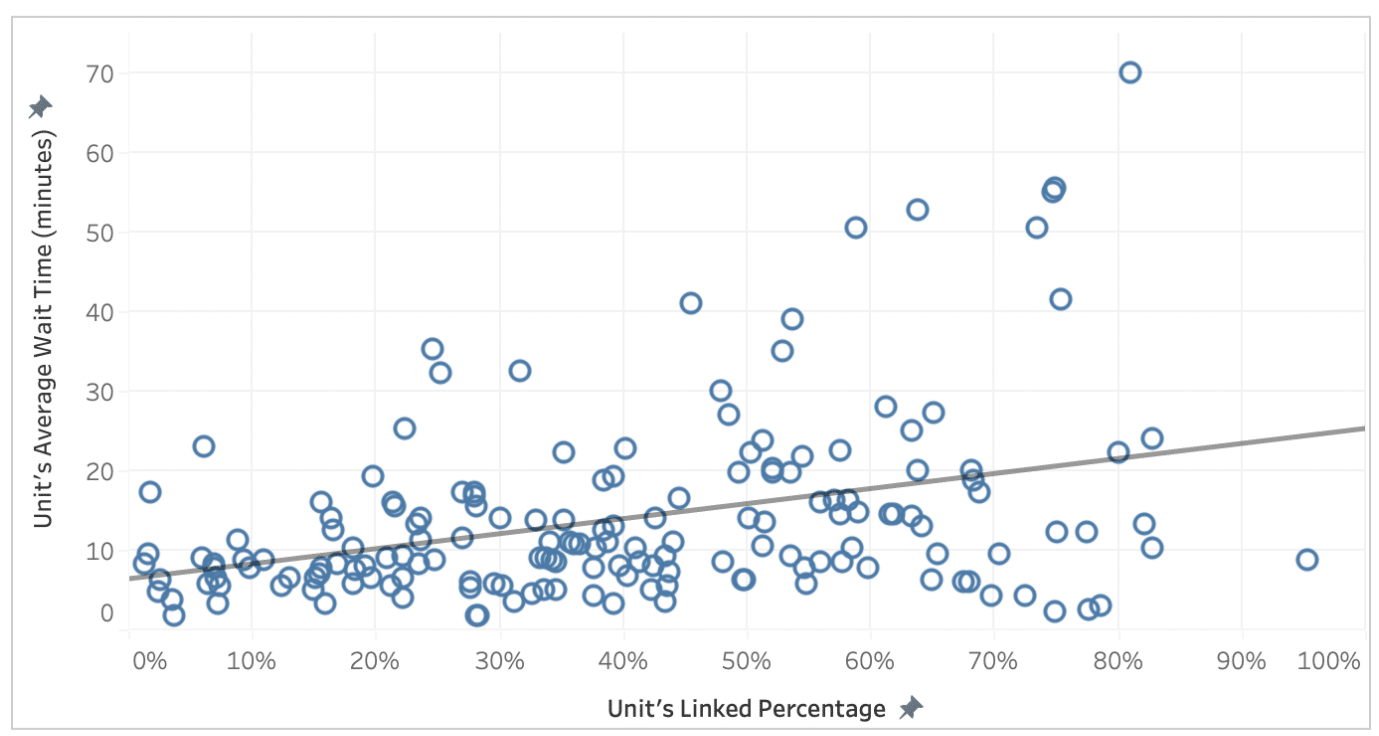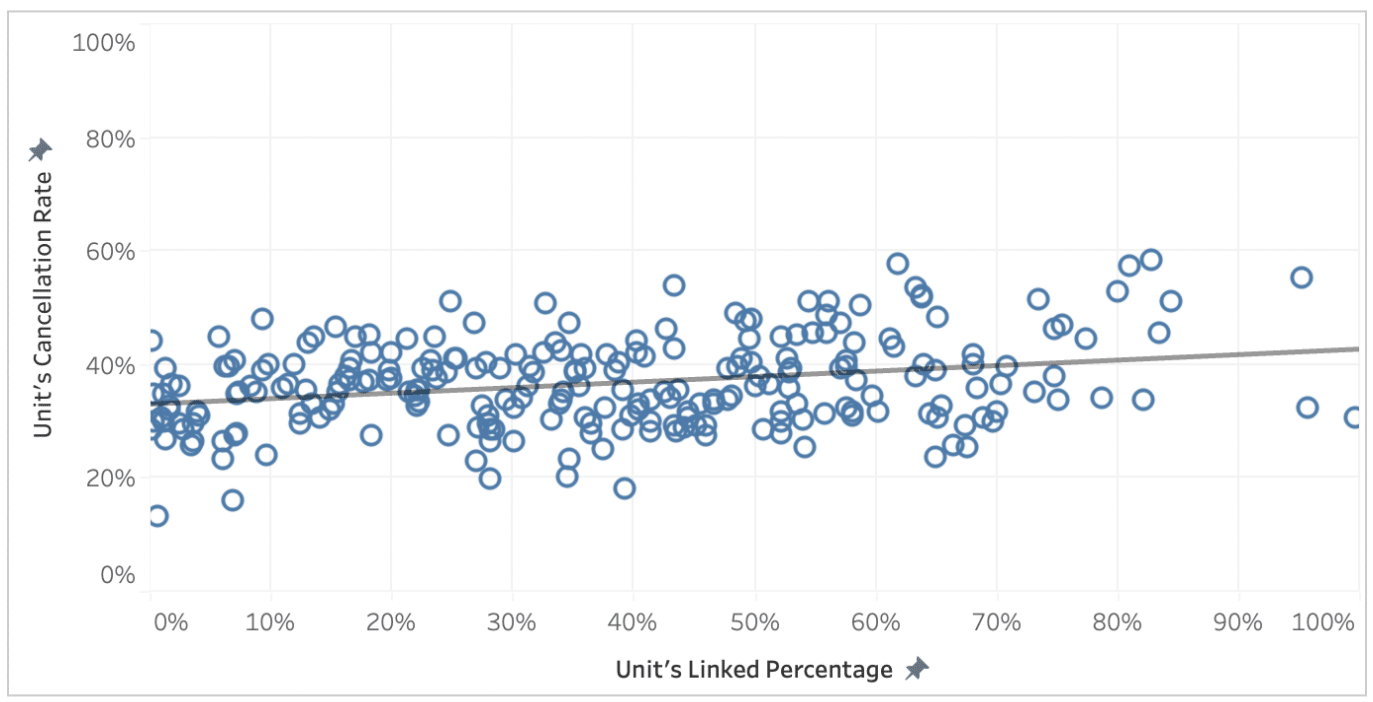At some point, every infusion center leadership team has likely discussed the goal of separating the individual appointments within their center (primarily the lab draw, office visit, and infusion room appointments) to occur on different days. Different centers may use slightly different terminology to describe multiple appointments on the same day, calling them “linked”, “coupled”, and/or “coordinated” appointments. Whichever term is used, the main goals of unlinking these visits are to create greater scheduling flexibility and optimize infusion center operations overall.
The proven positive outcomes of unlinking appointments support these goals. The graphs below show the relationship between linked percentage and two key operational metrics tracked by infusion centers across the US, wait times and cancellation rates.

Figure 1. Infusion Unit Linked Percentage relationship to Infusion Unit Average Wait Time

Figure 2. Infusion Unit Linked Percentage relationship to Infusion Unit Cancellation Rate
Figure 1 illustrates a high correlation between lower linked percentages and shorter average wait times in an infusion center. Although it is still possible to maintain low wait times with a high linked percentage, typically as the linked percentage increases, there is a greater risk of longer wait times and an increased variability in wait times. Figure 2 shows the rate of infusion appointment cancellations also increases as linked percentage increases due to the additional coordination required for same-day linked visits within an infusion center. When this happens, it often leads to re-work for schedulers to find new times for these patient appointments and more overbooks, causing operational stress in the center.
Even with this evidence of positive operational outcomes, infusion center leadership teams face several key challenges in response to unlinking efforts. These include:
- Lengthy patient travel: Some patients travel long distances for infusion center treatment, often multi-hour car trips to and from the center. Visits can sometimes even involve air travel. Unlinking infusion center visits may create an undue burden on these patients.
- Parking concerns: Some centers, especially those in larger metro areas, have limited parking and/or have parking areas that require patients to pay. Unlinking appointments can cause patients to deal with these frustrations and extra costs multiple times.
- Provider preference: Perhaps the most influential factor affecting linked visits is provider preference. Some providers are more insistent on seeing their patient and reviewing that patient’s medical situation on the same day than others. This reason within itself can vary widely based on disease group, patient population, and provider treatment norms.
Despite these challenges, thinking about unlinking appointments in more nuanced ways can help centers achieve the operational benefits of unlinking without needing to overhaul their scheduling approach to linked appointments.
Three creative approaches to linked appointment flexibility
1. Refocus efforts to appointments that are already unlinked
Most efforts related to unlinking appointments focus on the appointments that are same-day linked and how to separate these to occur on different days. Infusion centers however can find a lot of benefit in shifting focus to appointments that are already unlinked and putting extra effort in scheduling these appointments first thing in the morning or later in the afternoon. This will reduce the amount of clog during the “peak” hours resulting in increased appointment time availability for linked appointments (see also ‘How AI technology supports marginal thinking for optimized infusion scheduling’). As patient appointment times are thus spread throughout the day, creating a smoother pace of patients into the center, patients will wait for shorter periods overall. This spread will also create less stress on pharmacy and nursing workloads.
2. Be strategic about which linked appointments need to be unlinked
Many centers discuss unlinking infusion center appointments in broad strokes, often with a goal of unlinking all appointments. For most infusion centers struggling with the operational impacts of linked appointments, however, just a small change in the percentage of linked appointments typically has a relatively large impact.
For example, by unlinking a small number of appointments typically scheduled between 10:00 AM and 1:00 PM, it becomes possible to schedule these now unlinked visits either earlier or later in the day. This can often be as few as two to three appointments. Doing this will have an outsized impact on the operational flow by level-loading the pace of patients needing to be handled by nurses, medical assistants, pharmacy, etc.
Infusion centers can also be strategic by targeting busy days versus non-busy days. Many infusion practices have providers who travel across multiple locations depending on the day of the week, resulting in centers sometimes having many providers on site (creating busy days) or fewer providers on site (creating less busy days). Generally there is less of a need to unlink appointments on the less busy days, so by focusing on unlinking appointments scheduled on the busier days, infusion centers can achieve a proportionally larger impact from these efforts.
3. Explore the underlying reasons unlinked appointments cause operational inefficiencies and address those
Digging deeper into exactly why linked appointments are causing operational problems can identify opportunity areas to be improved. For instance, it may be discovered that certain provider schedules are configured in a way where any clinic visit requiring a same-day infusion must be scheduled in the morning, while visits that do not must be scheduled in the afternoon. This could be the underlying reason for the problem of not finding infusion room-appointment availability that matches well with clinic visits. Simply intermixing these two types of clinic appointments and spreading the same-day linked volume throughout the day will help smooth the pace of patients into the infusion room and unlock additional operating capacity.
Another possible cause is the underutilization of early morning infusion appointment times due to patients needing same-day blood draw appointments and then waiting on the lab results. While unlinking these blood draw appointments and scheduling them the day before is one solution, adjusting the operating hours of phlebotomy and the lab to open slightly earlier can achieve the same benefit without the need for unlinking. This approach unlocks the early morning infusion room appointment capacity, resulting in increased patient access and a smoother operating day.
A third underlying reason may be the assumption that same-day linking of appointments is always the patient’s preference. The common logic is that linking lab, clinic, and infusion appointments on the same day will always save a patient time, but there are many situations where a patient may prefer to have these appointments on separate days. For example, unlinking blood draw appointments to the day before treatment can allow patients to “wait” for lab resulting time outside of the infusion center, enjoying other activities in their lives rather than idly sitting in an infusion center waiting room. Unlinking appointments can also help some patients to schedule around other commitments such as child care, elder care, and work responsibilities. Incorporating each patient’s personal situation and preference, instead of making a single assumption about this, helps provide a positive infusion center experience and better patient ownership of the treatment journey.
By adopting these nuanced approaches, infusion centers can attain favorable results without needing to completely revamp their approach to linked appointments, thereby mitigating the common challenges associated with unlinking efforts. Utilizing advanced data analytics and AI-powered tools such as iQueue for Infusion Centers further aid in making fully informed decisions and optimizing operations within a particular infusion center. Ultimately, through creative scheduling and strategic thinking, backed by accurate data and supported by prescriptive technology suggestions, infusion centers can achieve successful and positive operational outcomes, including improved efficiency, reduced wait times, and enhanced patient experience.



